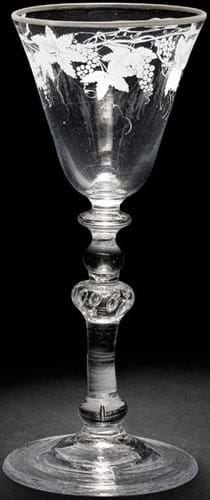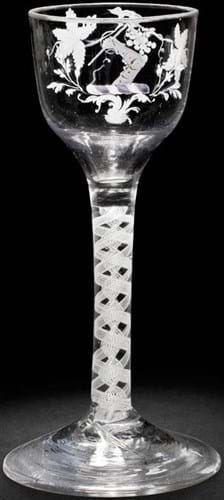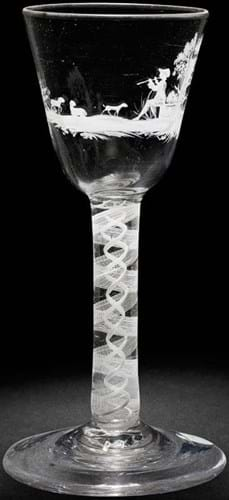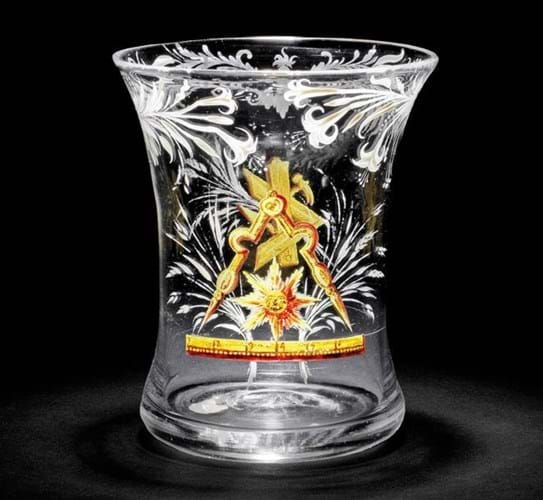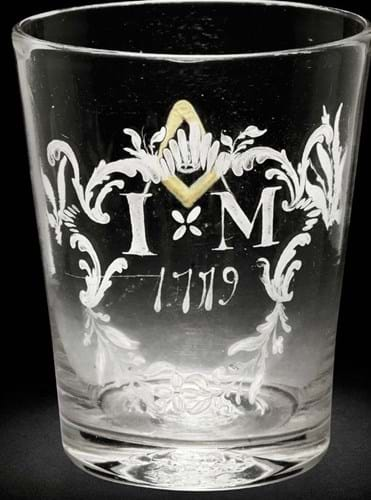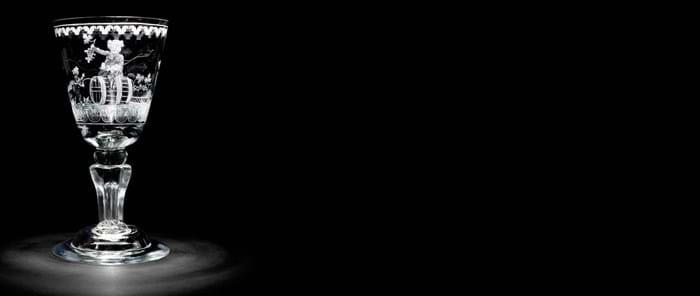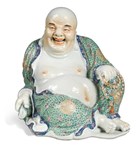Admire, definitely. Covet, certainly. But own? Sadly not.
However, for those lucky few with the time, the inclination and the funds, exceptional pieces – a combination of new discoveries and the changing of the collecting guard – have come to market in recent years.
The collection assembled by James Darell Thompson-Schwab (1936-2016) of Kingfield House, Carlisle, came for sale at Bonhams (27.5/25/20/14.5% buyer’s premium) on June 21-22. A retired stockbroker and Cumbrian landowner, he amassed a hefty 30 pieces of Beilby enamelled glass, many of them from collections sold since the turn of the 21st century.
A wine glass painted with the crest of the Thompson family in purple, white and yellow was one of his trophy pieces. Pictured in James Rush’s A Beilby Odyssey (1987) and previously exhibited at the Bristol Museum and Art Gallery, the Ashmolean Museum, Oxford and the Laing Art Gallery, Newcastle-upon-Tyne, it had sold in 2006 at Sotheby’s and again at the Chris Crabtree collection sale at Bonhams in 2010 (£12,000).
Fewer than 100 polychrome armorial glasses are known. This one is thought to mark the marriage of Henry Thompson (1743-1814) and Mary Spence (1750-1843) on 30 January 1769. To the wealthy Thompson family of Kirby Hall in Little Ouseburn, North Yorkshire, Mary brought her own considerable inheritance as the only child of Thomas Spence of Harts Hall, Suffolk.
While other Beilby crested and armorial wine glasses are known to have been made in sets, this is the only example so-far recorded bearing the Thompson crest. Estimated at £10,000-15,000, this time it made £15,000.
Almost the entire output
The Thompson-Schwab collection covered almost the entire output of Beilby styles and forms from firing glasses to ales, cordials and beakers.
A light baluster wine glass painted in white enamel with a meandering border of fruiting vine is one of only 15 known. Although once known as ‘Newcastle’ balusters, glasses of this distinctive form are now known to have been manufactured in Holland as well as England.
Despite their Tyneside location, it seems quite possible that the Beilbys did import their undecorated light baluster glasses from Holland. Most surviving examples of this shape with Beilby decoration have identical stems while of the 11 armorial glasses eight have Dutch connections.
This example with vine decoration (others are in the Fitzwilliam Museum and the V&A) took £11,000 (estimate £5000-7000).
A dozen small opaque twist wine glasses with rococo vignettes in opaque white sold for prices between £2200 up to £10,000. At the top end of the scale was a glass c.1765-70 with a round funnel bowl painted with a charming pastoral scene of a shepherd playing a pipe before his dog and two sheep. This had previously sold as part of the Henry Fox collection at Bonhams in 2004 (£13,500) and again as part of the Chris Crabtree collection (£9500).
A similar example from the Julius and Ann Kaplan collection was sold by Bonhams in November 2017 for £16,000 alongside an original watercolour signed by William Beilby which depicts a comparable scene (£1100).
Among the great Beilby discoveries of recent years was the 2005 car boot sale purchase (for 25p each) of four Beilby firing glasses decorated in red and yellow and white with Masonic emblems overlapping sprays of grasses and flowers. Two of the four were inscribed PT 1768.
Sold by Christie’s South Kensington in July that year for £18,000, the set was subsequently split (collectors tend to want to own just one example) and single tumblers have been sold by Bonhams. Two more appeared at Bentley’s in Kent in 2019 where, estimated at £50-80, they sold for £5400.
These six firing glasses match a larger 4in (10cm) tumbler in the Darell Thompson-Schwab collection. It had previously sold for £8000 (at Sotheby’s in 2006 and again as art of the Crabtree sale four years later) but this time was allowed to get away just below estimate at £4500.
Another slightly smaller Masonic tumbler in the sale – this one inscribed IM 1779 – took £5500. Similar in size and form to another in the Corning Museum of Glass inscribed and dated M Bell 1778, this is thought to be the latest datable piece of glass from the Beilby workshop.
While William Beilby (1740-1819) is known to have still been living in Newcastle in 1778, he and sister Mary had moved to Battersea by 1779 and no further glass appears to have been decorated by the family after this.
Ceremonial goblet
Leading Bonhams’ sale was this splendid 11½in (29cm) high engraved ceremonial goblet, c.1730-40. The decoration to the massive funnel bowl of Bacchus seated astride a barrel flanked by putti gives a clue to its contents and how it would have been used around a banqueting table.
Once thought to be German work, current scholarship leans towards a Netherlandish hand.
An extensive 20th century collecting provenance adds to its appeal. Pictured in both Francis Buckley’s Old English Glass (1925) and LM Bickerton’s Eighteenth Century English Drinking Glasses (1986), it has been owned by a long list of high-level collectors including WHP Leslie, Hamilton Clements, William Randolph Hearst and WA Evill.
It came for sale at Bonhams from the collection of Patrick and Mavis Walker with an estimate of £800-12,000, and took £33,000.


